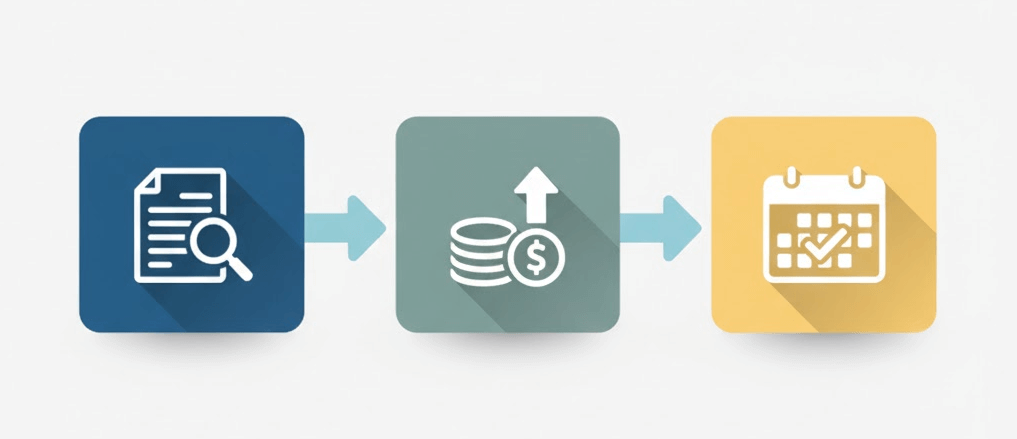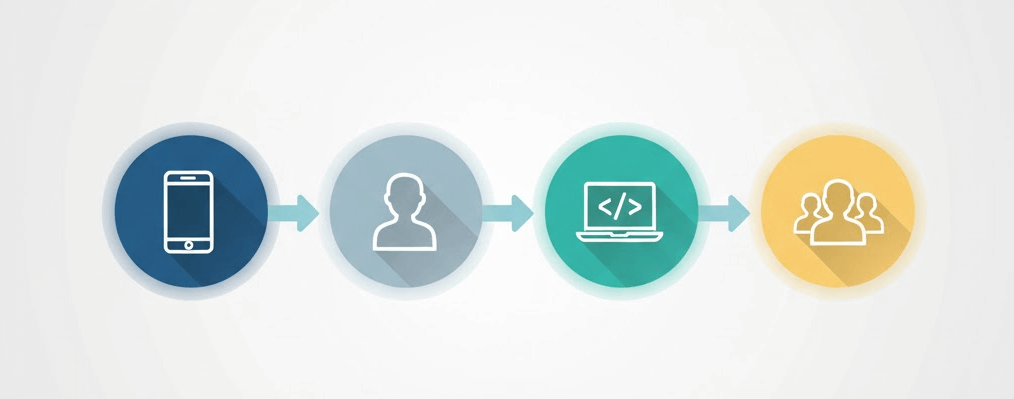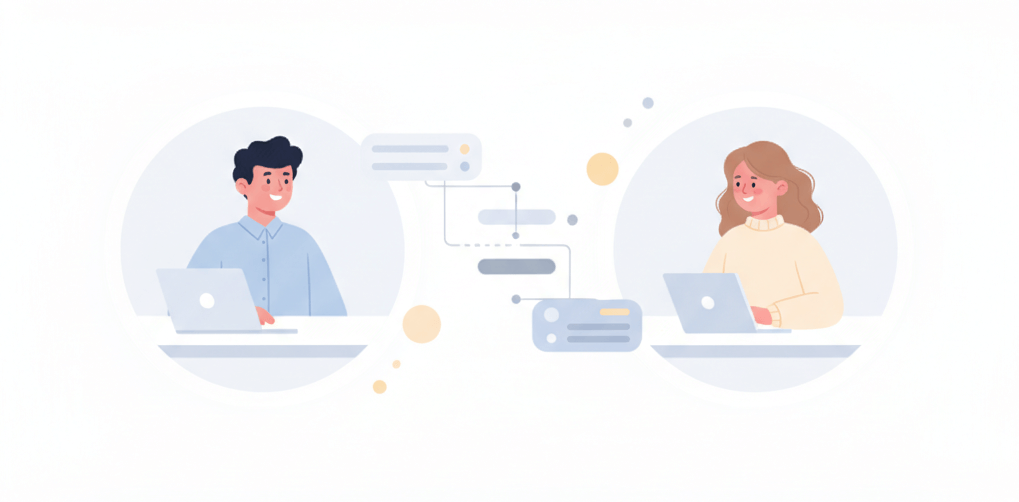Running an effective IT job interview takes more than intuition. It’s about structure, focus, and fairness. The best interviews last 45–60 minutes, follow a clear framework, and assess both technical skills and cultural fit. In fact, 72% of employers now rely on structured interviews to reduce bias and improve hiring decisions. This guide is for hiring managers, founders, and HR professionals who are recruiting for European IT roles.
How to prepare for an IT job interview
Before scheduling any IT job interview, request an updated CV, salary expectations, and availability from every candidate. These three pieces of information prevent wasted time on misaligned candidates and surface potential issues.

Review CV details that need clarification
Long career gaps (3+ months)
Ask what they did during unemployment. Common reasons include retraining, family care, relocation, or taking a break. Red flag: vague answers or defensiveness.
Vague job descriptions
When a marketer lists “content creation,” it’s important to clarify whether they create the content themselves or manage external agencies. Another example: If you’re preparing for a tech job interview, delve into a candidate’s specific projects and their exact role.
Skills without context
React experience can range from a single component to an entire application. Always clarify depth during interviews.
Assess salary fit early
Compare each candidate’s salary expectations against your budget immediately.
Especially critical for European candidates: Clarify the salary structure. Specify whether figures are gross or net, and explain bonuses, pension contributions, and benefits that vary by country.
Gain clarity on the candidate’s availability
Check their notice period or contract end date. Note that speed matters, as most job candidates won’t wait around. Only 29% stay interested after a week.
Red flags to watch out for in a job candidate
Certain patterns in CVs and LinkedIn profiles correlate strongly with retention problems or misinformation. Here’s what to check before spending time on a job interview. 👇
LinkedIn and CV mismatches
Different job titles, dates, or company names suggest dishonesty or carelessness. Ask directly: “I noticed your LinkedIn shows you worked at Company X until June 2024, but your CV says August 2024. Can you clarify?”
Job hopping
Frequent job changes (occurring more than once per year) raise concerns about retention. However, contract work is common in Germany, the Netherlands, and the Nordic countries. For permanent roles, a minimum tenure of 2–3 years per position is recommended.
Sudden career changes
If a developer has transitioned into a project manager role, there should be a clear explanation for this career change. Were they pushed out? Did they discover a leadership passion? This reveals decision-making patterns.
Incomplete education
Failure to finish degrees or certifications shows poor planning or a lack of follow-through. Exceptions: amazing job offers, emergencies, or irrelevant programs.
Must-have stages of an IT interview
Most successful hiring processes use 4 distinct stages in IT job interviews. Meanwhile, companies recruiting for junior roles often combine stages 2 and 3 for efficiency. Each stage serves a specific purpose in filtering candidates.
| Stage | Duration | Purpose | Who conducts |
| 1. Pre-interview call | 15–20 min | Confirm experience, gauge interest, and answer basic questions | IT recruiter or HR |
| 2. IT HR interview | 30–45 min | Assess career path, job search reasons, and cultural fit | HR or hiring manager |
| 3. Technical interview | 45–60 min | Evaluate skills through questions and project examples | Technical lead or team member |
| 4. Team introduction | 30–45 min | Assess interpersonal fit, answer detailed team questions | Future colleagues/manager |

How long should IT job interviews last?
45 to 60 minutes is ideal. Shorter job interviews miss details. Longer ones suggest poor preparation.
Set expectations upfront: “This interview should take 50 minutes. I’ll cover your background first, discuss the role, and leave time for your questions.”
The exact duration depends on the interview approach:
- Structured: Same core questions for every job candidate in the same order. Reduces bias, makes comparison easier. Best for junior to mid-level roles.
- Flexible: Key points requiring clarification, but no fixed order. Natural conversation flow. Best for senior candidates who expect strategic discussions.
- Hybrid: 5–7 core questions for consistency, but allow flexibility to dig deeper.
5 key steps in every interview for IT jobs
A good IT job interview follows five clear steps:
- Greet and set expectations
- Share the company or team context
- Explore background, skills, and experience
- Assess understanding, motivation, and fit
- Discuss logistics and next steps
These steps keep interviews consistent, focused, and comparable, so every candidate is evaluated on the same ground. Let’s dive into each one.
Step 1: Greet and set expectations (2–3 minutes)
Welcome the candidate warmly and clearly outline the structure and purpose of the interview. Adjust phrasing depending on the stage: A pre-interview call might be brief, while a technical interview or team introduction may have more depth.
Example: “Hello, thanks for joining. Today, we’ll focus on your background and the role, and there will be time for your questions at the end. Does that work for you?”
Step 2: Share the company or team context (5–7 minutes)
Briefly explain the company, team, or project relevant to the interview. Highlight why the candidate’s skills or experience could apply to this stage. Keep it flexible for any type of job interview.
Example: “Your experience with cross-functional projects could be valuable for this team’s current initiatives.”
Step 3: Explore background, skills, and experience (20–25 minutes)
Ask about career history, achievements, projects, problem-solving, and teamwork. Adapt the depth depending on the stage:
- Pre-interview call: High-level overview.
Example: “Can you briefly walk me through your most recent roles and key responsibilities?”
- IT HR interview: Focus on motivations, career path, and culture fit.
Example: “Describe a time when you had to collaborate with a team under tight deadlines. How did you handle it?”
- Technical interview: Learn more about skills, tools, and problem-solving.
Example: “Which tools or technologies did you use, and why did you choose them?”
- Team introduction: Explore collaboration style and interpersonal fit.
Example: “How do you usually communicate updates or challenges with your team?”
Step 4: Assess understanding, motivation, and fit (5–7 minutes)
Check that the candidate understands the role, project, or team, and explore what motivates them. Be flexible to uncover interest or fit for alternative roles if applicable.
Example: “Would you be open to similar opportunities if this position isn’t the perfect match?”
Step 5: Discuss logistics and next steps (5–7 minutes)
Cover practical details relevant to this stage: salary, benefits, start date, equipment, or trial periods. Always clarify next steps, how feedback will be provided, and the timeline for the decision. Follow up within 24 hours whenever possible.
Example: “For this role, the base salary range is €50,000–€60,000 gross per year, plus a performance bonus. We offer standard benefits, including 25 days of vacation and health insurance. You would ideally start in November, and we provide all necessary equipment, including a laptop and monitor.
After today, we’ll review all candidates and get back to you within a week. If you advance, the next step will be a meeting with the team lead. Do you have any questions about these details?”
Best IT interview questions in 2025
The IT job interview questions you ask determine what you learn. Structure 80% of your interview around open-ended questions. These encourage candidates to share insights, experiences, and thinking processes. Use closed questions only for specific tactical purposes, such as confirming facts.
Open questions
These are the best IT interview questions, so you should structure most of the conversation around them. They reveal thinking processes, not just facts.
Career path questions
- “Walk me through your progression from developer to tech lead. What prompted each transition?”
- “Why did you leave your position at Company Y?”
- “How did working in Germany differ from your previous role in Poland?”
Situational questions
- “Describe a time you disagreed significantly with a team member. How did you handle it?”
- “Have you worked with distributed teams across countries? What challenges did that create?”
Behavioral questions
- “If you could change your previous company’s bonus system, what would you improve?”
- “What management style brings out your best work? Give an example.”
- “Describe your ideal work-life balance.”
Provocative questions
- “If a customer pays well, they’re always right. Agree or disagree?”
- “Is it ever acceptable to miss a deadline? When?”
Incorrect statement questions
- “So you used React for the backend?” (React is frontend)
- “You stored passwords in plain text?” (terrible security)
Note: These are a kind of technical questions for IT interview. So, only tech specialists should ask these. Be ready to explain that you were testing your knowledge.
Case study questions
- “A client wants a feature that compromises security and insists it is essential. Walk me through how you’d handle this.”
- “You join a project with poor documentation, and the original developers have left. You need to add a major feature in three months. What are your first steps?”
Closed questions (yes/no)
Use strategically, not as your primary approach:
- Summarizing: “Did I understand correctly that you have Kubernetes experience?”
- Clarifying facts: “Is your expected salary €65,000 gross annually?”
- Politely interrupting talkative candidates: “So working with freelancers isn’t a problem?”
- Returning to unanswered questions: “Do you have experience with the German market specifically?”
- Forcing choices: “Would you prefer more vacation days or quarterly bonuses?”
Advanced interview techniques
Leverage these techniques when hiring for senior roles, assessing culture fit for tight-knit teams, or when candidates give rehearsed answers to standard questions.
Negation
Focus on unsuccessful experiences to understand how candidates handle failure and learn.
Example: “Tell me about a project that didn’t go as planned. What went wrong and what did you learn?”
Projection
Place candidates in scenarios indirectly as advisors or mentors.
Example: “How would you rate a team leader who tries to manage all processes personally?”
Unfinished sentences
Reveal how they see their development.
- “Five years from now, I want to be…”
- “The most important factor in my next role is…”
Layering
Explore one topic with different question types in sequence to check consistency.
- “At Company X, the development system was most important to you. What made it effective?”
- “How could it be improved?”
- “What’s more important: financial incentives or learning opportunities?”
- “Why would your version work better?”
Compare answers for consistency with earlier statements.
![]()
How to evaluate and compare job candidates (without forgetting who said what)
If you’re interviewing for IT job with 3–5 candidates in one week, they blur together. Evaluate systematically to avoid hiring based on “gut feel” or recency bias (favoring whoever you spoke with last).
Evaluate within 30 minutes of the interview
Score each candidate on 5–7 predetermined criteria using a 1–5 scale:
- Technical competency (relevant to role level)
- Problem-solving approach
- Communication clarity
- Cultural fit with the team
- Motivation and engagement with the role
- European work authorization/logistics
- Salary alignment with the budget
For each score, note 2–3 specific examples that justify it.
Example: “Communication: 4/5 — Explained microservices architecture clearly to a non-technical interviewer, asked clarifying questions before answering, stumbled slightly when discussing conflict resolution.”
Write one sentence: “I would/wouldn’t hire because…”
Compare candidates against criteria, not each other
The best candidate from a weak pool is still a weak hire. If no one scores above 3/5 on most criteria, extend your search.
Decide while the candidate is still engaged
- Day 1–2: Complete all first-round interviews
- Day 3: Review scores and notes, advance 2–3 candidates
- Day 4–5: Conduct second-round interviews
- Day 6: Make an offer to the top candidate
- Day 7–9: If declined, offer the second choice
Document while it’s fresh
Thorough notes (whether manual or AI) reduce uncertainty and provide valuable data for improving your process over time.
Tell candidates upfront: “I’ll take notes to remember our conversation accurately.” Focus on facts and specific examples, not subjective impressions like “seemed nervous.”
Summary: Your interview framework
Before: Collect CVs, salary expectations, and availability. Review for red flags. Prepare specific questions based on backgrounds.
During: Follow clear structure (greeting, company presentation, experience discussion, assessment, compensation, next steps). Use primarily open questions with strategic closed questions. Apply advanced techniques to reveal deeper insights.
After: Provide feedback within 48–72 hours. Document evaluations while fresh. Compare candidates against defined criteria, not each other.
For European candidates specifically:
- Clarify gross vs. net salary early
- Understand that notice periods vary by country
- Respect work-life balance expectations (especially Northern Europe)
- Be prepared for direct questions and intellectual discussions
- Accommodate language differences professionally
The structure and questions here reflect what we use successfully at DNA325 for European IT recruitment. Adapt them to your needs, industry, and culture.
Facing challenges when interviewing tech talent from Europe? Talk to us.
Frequently asked questions on interviewing for IT job
Most companies use 2–4 stages:
• Phone screening (15–30 min.)
• HR interview (30–45 min.)
• Technical interview (45–60 min.)
• Team meeting (30–45 min.)
Combine stages 2 and 3 for junior positions.
Avoid questions about age, marital status, plans for children, religion, political beliefs, nationality (unless a genuine job requirement), disabilities (unless directly relevant), or sexual orientation.
You can ask: “Are you authorized to work in…?” and “Can you work the required hours?”
Yes. Tell candidates upfront: “I’ll take notes to remember our conversation accurately.” Focus on facts and specific examples, not subjective impressions. With 60% of hiring leaders expressing doubt about hires, notes reduce uncertainty.
Use structured interviews, define evaluation criteria before interviewing, involve multiple interviewers, focus on skills and behaviors (not personality), and take breaks between interviews.
Be flexible with scheduling (offer early morning, lunch, or evening slots). Keep communications professional (email or LinkedIn, not work calls). Understand notice periods (1–3 months in many European countries) and be discreet.
Same day: Send thank-you message. Within 48–72 hours: Provide a decision or timeline update. Within one week: Complete feedback for advanced candidates. 21% of candidates wait only 2–6 days for feedback.
Yes. For remote roles, add questions about previous remote work experience, home office setup, communication preferences, time management without supervision, and handling isolation.
Use behavioral questions with the STAR method (Situation, Task, Action, Result). Example: “Tell me about a time you convinced a skeptical stakeholder. What was the situation, your approach, and the outcome?”
Pay attention to communication clarity, responsibility vs. blame, team dynamics descriptions, and specific examples vs. vague generalizations.
Ask if they have questions, explain next steps clearly (“I’ll contact you by Friday”), thank them professionally, and follow up in writing within 24 hours. Never end ambiguously.



